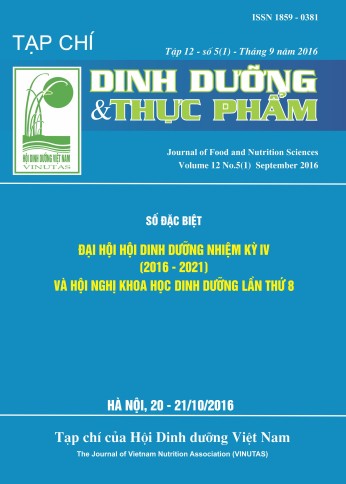EFFECTS OF MILK CONTAINING PROBIOTIC AND PREBIOTIC ON NUTRITION AND MICRONUTRIENT STATUS OF CHILDREN 18-36 MONTHS
Main Article Content
Abstract
The Study aimed to evaluate the effects of milk formula enriched with probiotic and prebiotic (Synbiotic) on nutritional and micronutrient status of children from 18 to 36 months old. Methods: In a randomized, double blind, controlled trial, children were randomized to receive milk formula with (Synbiotic group) or without Synbiotic (Control group) for 5 months (400ml/day x 5 days/week). Length, weight, Z-scores and blood samples were collected at baseline and end of intervention for assessment of nutritional, anemia, vitamin A, and zinc status. Results: After 5 months, the Synbiotic group showed a higher value in weight and length gain (+0.39 kg và 1.04cm, p<0.01) compared to control group. The Hb, Zinc and Retinol levels were improved in both groups vs. baseline, but no significant difference (p>0.05) between synbiotic and control group.
Keywords
Nutritional status, probiotic, prebiotic, retinol, Zinc, Hb
Article Details
References
2. Trần Thị Lan (2013). Hiệu quả của bổ sung đa vi chất và tẩy giun ở trẻ 12-36 tháng tuổi, suy dinh dưỡng thấp còi, dân tộc Vân Kiều và Pakoh huyện Đakrong, tỉnh Quảng Trị. Luận án Tiến sỹ Dinh dưỡng, Viện Dinh dưỡng.
3. Nguyễn Xuân Ninh, Dương Thị Tình và CS (2009). Hiệu quả của sữa có probiotic và probiotic đến tình trạng dinh dưỡng, nhiễm khuẩn, miễn dịch của trẻ 18-36 tháng tuổi. Đề tài nghiên cứu khoa học cấp Viện - Viện Dinh Dưỡng, Hà Nội 2009.
4. Viện Dinh dưỡng (2016). Số liệu thống kê về tình trạng dinh dưỡng trẻ em qua các nănm (1999-2015). http://www.viendinhduong.vn/news/vi/106/61/0/a/so-lieuthong-ke-ve-tinh-trang-dinh-duong-tre-em-qua-cac-nam.aspx.
5. Bergonzelli GE, Blum S, Buressow H, Corthesy-Theulaz I (2005). Probiotics as a treatment strategy for gastrointestinal diseases? Digestion 338: 1-12
6. Collin MD, Gibson GR (1999). Probiotics, prebiotics, and synbiotics: approaches for modulating the microbial ecology of the gut. Am J Clin Nutr 69 (suppl): 1052S–1057S.
7. Guarner F (2005). Inulin and oligofructose: impact on intestinal disease and disorders. Br J Nutr 93(Suppl 1): 61-65.
8. IVACG (1982). Biochemical methodology for assessment of vitamin A status. The nutrition foundation Washington, D.C,USA.
9. IZnCG (2004). Assessment of the risk of Zinc deficiency in population and options for its control. Food Nutr Bull 25(suppl 2): 99-203.
10.Kuman RS, Brannigan JA, Prabhune AD, et al (2006). Structural and functional analysis of a conjugated bile salt hydrolase from Bifidobacterium longum reveal an evolutionary relationship with penicillin V acylase. J Biol Chem 281(43):32516-32525.
11.Sazawal S, Dhingra U, Hiremath G, et al (2010). Effects of Bifidobacterium lactis HN019 and prebiotic oligosaccharide added to milk on iron status, anemia, and growth among children 1 to 4 years old. J Pediatr Gastroenterol Nutr 51(3): 341-346.
12.Schrezenmeir J, Deverese M (2001). Probiotics, prebiotics, and synbiotics – approaching a definition. Am J Clin Nutr 73: 361-364.


